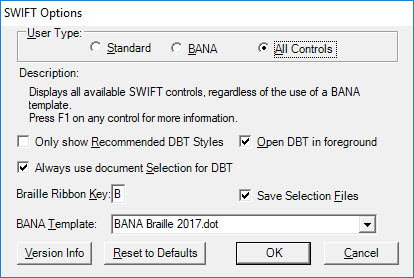Data Entry of Inkprint Mathematics Notation
To enter inkprint mathematics notation into DBT, you need to make use of a software tool that can write mathematics notation. Thankfully, there are a variety of tools, and many are easy to learn.
Here are some data entry methods you can use to create math braille directly or to import a math file into DBT:
- Enter the math directly in DBT.
- Use MathType as a Word add-in to create math to open in DBT.
- Use Office math shortcuts to enter math as Office Math Markup Language (OMML) equations. Then use MathType to convert the OMML equations to MathType equations.
- Enter math in Word without using MathType or creating OMML equations.
- Use a LaTeX editor, such as Scientific Notebook, to create a .tex file to open in DBT.
- Work with a TeX or LaTeX file created in other ways, e.g., created in a different math word processor (perhaps by the professor), created from math OCR with InftyReader or MathPix, etc.
By the way, if you are not experienced with braille mathematics, we recommend you have your braille math checked by a braille proofreader.
The Recommended Tool Set
- DBT (12.7)
- Microsoft Word (2007 or above)
- MathType (currently version 7.4)
- SWIFT 5.5 (available for Windows only.)
- The "BANA Braille 2017.dot" template for Microsoft Word (Optional, available for Windows only.)
Note: While Duxbury Systems recommends certain third-party software, please note that general support for third-party products is provided by the developer and not by Duxbury Systems. Of course, Duxbury supports you for issues relating to importing these files and braille translation.
About These Tools
- In North America, to produce math using Nemeth Code, use the DBT template, "English (UEB) - BANA with Nemeth", or to produce math using UEB Math Code, use the template "English (UEB) - BANA". In the United Kingdom, use "English (UEB) - UK Formatting". For all other languages, use the template for that language.
- SWIFT 5.5 is a free product from Duxbury Systems. See below about setting up SWIFT in Word (for Windows only; primarily for English language use).
- Microsoft Word is available from many sources.
- The "BANA Braille 20xx" templates are supplied with DBT to use with Microsoft Word for Windows. Using SWIFT 5.5 makes it easy to attach this template to your Word documents.
- The MathType formula editor is available from Design Science (price $97, academic price $57, at last check). MathType users construct mathematics and scientific equations in a WYSIWYG editing environment. These formulas are subsequently embedded in the Microsoft Word document. You need to install MathType to import these Word documents into DBT.
- Scientific Notebook - a program that works as a word processor for mathematical notation, which generates LaTeX files (specialized text files) that DBT can import. DBT translates the file to produce correct braille for both the text and mathematical notation. Duxbury Systems supports Scientific Notebook 5.5. Note, however, that MacKichan Software ceased business in 2021. See http://www.mackichan.com. A simple manual for Scientific Notebook may still be available at http://www.sciword.co.uk/SNB.pdf.
- InftyReader is optical character recognition (OCR) software. It converts printed documents or PDF files, including mathematical notation and tables, into computer-recognizable text and symbols. It can output the results in various formats including LaTeX, which DBT can import. To use InftyReader requires a high-resolution scanner (400 or 600 dpi). InftyReader information is available at http://www.sciaccess.net/en/InftyReader/index.html.
Setting up SWIFT in Word (Windows Systems Only)
Note: Those working in languages other than English do not get any advantage by using SWIFT. If you are not using English, you can skip this step.

As shown above, installing SWIFT adds a Braille tab to the ribbon interface in MS Word. Upon opening the Braille tab, your first step should be to open the Options dialog.

In the Options dialog, you can check "BANA" as your User Type. This configures the ribbon to the optimal set of controls.

Once you set the User Type, you see that the left-most option in the Braille tab becomes Choose Template, which provides a choice of BANA templates according to the Braille rules and math code you wish to use. Choosing one replaces the default Word template (Normal.dot) with a template that contains styles appropriate for braille production.